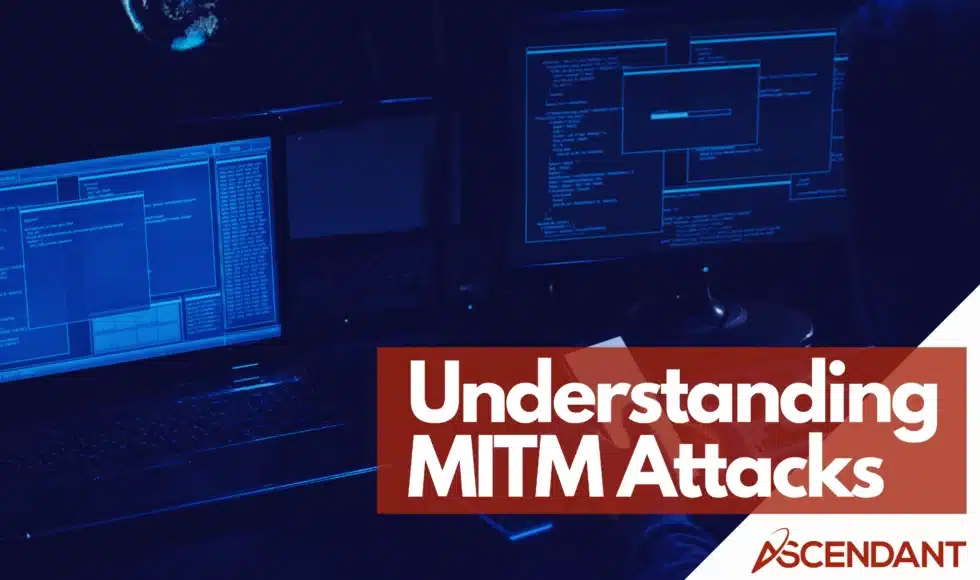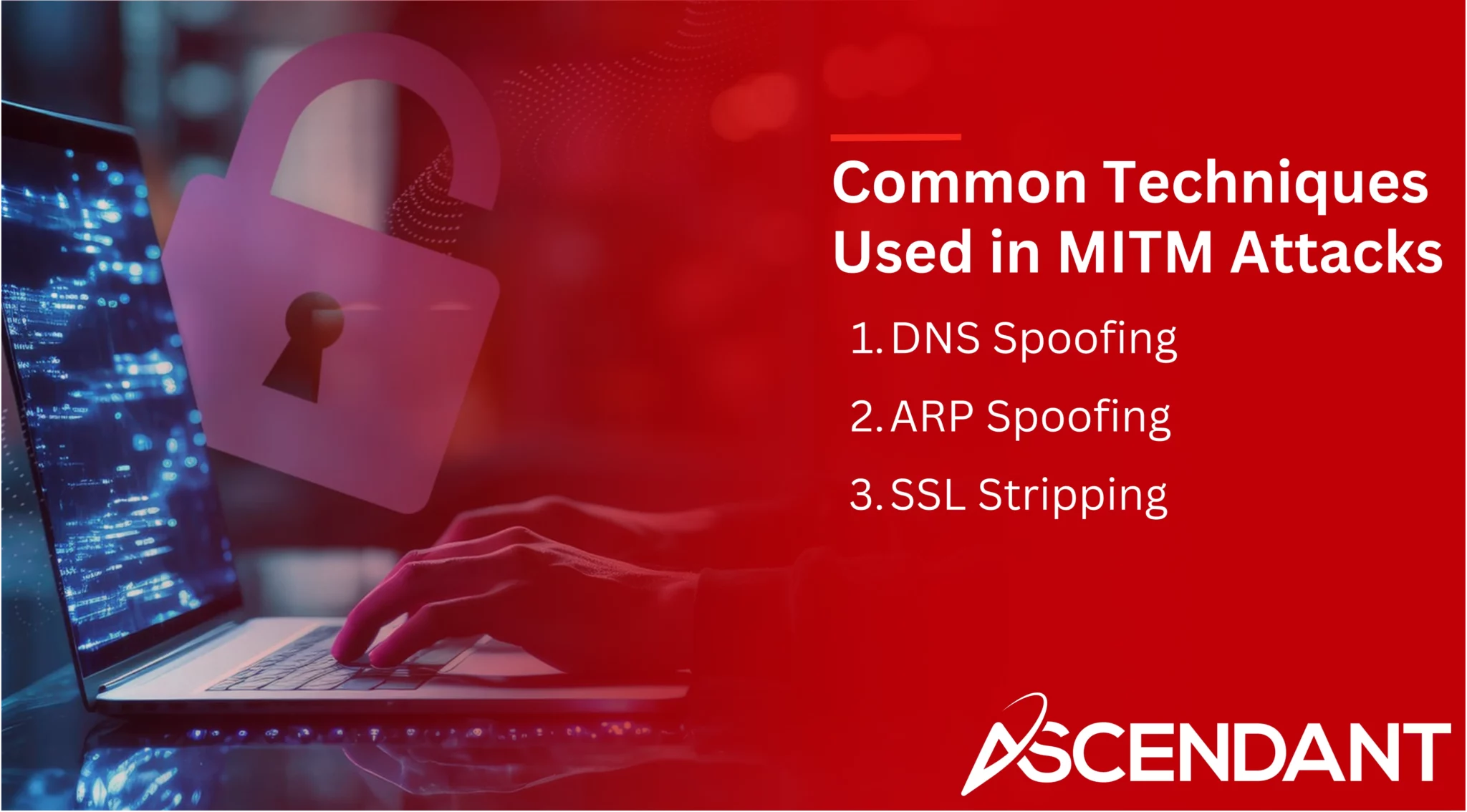MITM attacks intercept communication between two parties, allowing attackers to steal or alter data. In this article, you’ll learn what MITM attacks are, how they work, and how to protect yourself.
Key Takeaways
- MITM attacks involve intercepting communication between two parties, allowing attackers to steal sensitive information or modify the exchanged data without the victims’ awareness.
- Common techniques used in MITM attacks include DNS spoofing, ARP spoofing, and SSL stripping, all of which exploit vulnerabilities in network protocols to compromise data security.
- Preventing MITM attacks requires a combination of strategies such as using VPNs, enforcing HTTPS protocols, and implementing strong authentication methods to secure communications effectively.
Understanding MITM Attacks
An attack known as a MITM (Man-In-The-Middle) occurs when an attacker covertly relays and possibly modifies the data exchanged between two parties who believe they are directly communicating with each other. The insidious nature of this kind of cyberattack lies in its ability to remain undetected by the legitimate communicators.
During these attacks, perpetrators exploit weaknesses within network protocols and communication channels to intercept information flowing between a client and server, allowing them to insert deceptive information into the conversation. To fully understand how such assaults take place, it is essential to familiarize oneself with what constitutes a MITM attack along with its fundamental characteristics.
Definition of MITM Attack
A Man-in-the-Middle (MITM) attack is a sophisticated cyber intrusion where an attacker intercepts communication between two parties, often by compromising the Internet router or using a rogue access point to manipulate traffic. The main objective is to steal personal information, like login credentials and account details, potentially leading to identity theft or unauthorized changes to accounts.
Techniques such as SSL stripping and DNS cache poisoning are used to downgrade secure connections and redirect users to fraudulent websites.
Key Concepts in MITM Attacks
MITM attacks, such as session hijacking and ARP spoofing, are critical techniques for attackers. In session hijacking, an attacker captures a user’s session token to gain unauthorized access and operate as the user. The Address Resolution Protocol (ARP) plays an important role in network communications by mapping IP addresses to their corresponding MAC addresses.
By sending counterfeit ARP messages that associate their own MAC address with another user’s IP address, assailants can divert data intended for the rightful recipient. Through these methods, attackers have the ability to monitor and alter exchanges of data within the network.
Common Techniques Used in MITM Attacks
MITM attackers employ a range of methods to capture and alter data as it moves across a network. Among these techniques, DNS spoofing, ARP poisoning, and SSL stripping stand out for their effectiveness in exploiting vulnerabilities within different protocols.
These attacks can be launched using sophisticated automated software or carried out manually by the attackers themselves. This adaptability makes them particularly hazardous threats within any network environment.
DNS Spoofing
Manipulating DNS records, a tactic known as DNS spoofing, reroutes user traffic from genuine websites to deceitful counterparts. Such actions lead to the potential theft of data or the installation of malware, which erodes trust in online security for users.
ARP Spoofing
Attackers utilize ARP spoofing by transmitting false ARP communications over the network to associate their own MAC address with someone else’s IP address. By doing so, they are able to divert and intercept data that was originally intended for another device’s IP address through the manipulation of ip spoofing.
SSL Stripping
SSL stripping undermines the security of data by converting protected HTTPS connections into vulnerable HTTP ones. This process enables attackers to intercept and tamper with communications, thus putting sensitive information at risk of being compromised.
Real-World Examples of MITM Attacks
The gravity of MITM attacks is underlined by notable real-world incidents, such as the breaches at DigiNotar and Equifax. These events had profound repercussions and emphasized the vital importance of stringent cybersecurity measures.
DigiNotar Breach
The 2011 DigiNotar incident, in which attackers stole 500 certificates to masquerade as over 300 authentic websites such as Google and Yahoo, underscored the susceptibility of digital certificates and significantly diminished user confidence.
Equifax Data Breach
In 2017, Equifax suffered a data breach because their applications did not consistently employ HTTPS. This security lapse allowed attackers to capture the personal information of roughly 147 million people through an app that masqueraded as genuine. As a result of this incident, Equifax withdrew its apps from both the Apple and Google stores to prevent the intercept of user data.
Industries Most Vulnerable to MITM Attacks
Industries such as financial services, healthcare, and small to medium-sized businesses (SMBs) are particularly at risk of falling victim to MITM attacks because they process sensitive information that is highly appealing to cyber criminals.
Financial Institutions
Due to their management of critical financial assets and data, banks and financial institutions become prime targets. The nature of the sensitive information they deal with creates chances for it to be intercepted and misused, thus compelling the need for strong cybersecurity defenses.
Healthcare Sector
Healthcare systems are prime targets for MITM attacks as they often transmit sensitive patient data over unsecured networks. Techniques like DNS spoofing can redirect healthcare communications through malicious servers, leading to severe consequences such as identity theft and unauthorized access to medical records.
Strong security protocols are vital to protect healthcare communications.
Small and Medium Businesses (SMBs)
Due to their typically weaker cybersecurity defenses, small and midsize businesses (SMBs) are more prone to falling victim to MITM attacks compared to larger corporations that implement stronger protective measures. These limited resources in cybersecurity leave SMBs especially vulnerable to such attacks.
How to Prevent MITM Attacks
To thwart MITM attacks, a comprehensive strategy is vital. This includes the implementation of VPNs, adherence to HTTPS protocols, the creation of robust login credentials, and effective media access control measures. By adopting these methods, one can greatly reinforce the security surrounding data exchanges and diminish potential access for nefarious individuals intent on capturing sensitive information.
Use VPNs for Secure Communication
A virtual private network safeguards sensitive data by encrypting the streams of data communication, thus maintaining confidentiality across shared networks. The utilization of a VPN becomes crucial when using public Wi-Fi to ensure the security of communications.
Enforce HTTPS Protocol
HTTPS plays a fundamental role in establishing secure web communications. It ensures that all data transmitted is encrypted, which prevents the possibility of interception and guarantees secure communication pathways. To safeguard the integrity of user data, it’s essential for websites to protect every single page with SSL/TLS encryption.
Strong Login Credentials
To protect against unauthorized access, it is crucial to use robust and distinctive login credentials. Login security can be greatly improved by implementing strong authentication processes, such as multi-factor authentication, which address the weaknesses found in conventional password systems.
Detecting MITM Attacks
Detecting MITM attacks requires monitoring network traffic for unusual patterns or signs of tampering. Tools like Wireshark and Tcpdump analyze network traffic, while intrusion detection systems identify unauthorized access or communication, uncovering potential weaknesses.
Monitoring Network Traffic
Packet inspection is a vital technique for analyzing network traffic and identifying irregularities. Inspecting encryption patterns and timing discrepancies can help recognize and mitigate potential MITM attacks.
Tamper Detection Systems
Tamper detection systems monitor communications and alert users to any unauthorized modifications. These systems can identify inconsistencies in SSL/TLS certificates, indicating potential MITM interception.
Strengthening Application Security
Strengthening application security involves implementing secure coding practices and conducting regular security audits. These measures help identify and rectify vulnerabilities that attackers might exploit in MITM scenarios.
Implementing Secure Coding Practices
Adopting secure coding standards can minimize vulnerabilities that attackers often exploit in MITM scenarios. Static code analysis tools help developers identify security flaws early in the software development process, while input validation safeguards applications from attacks like SQL injection and cross-site scripting.
Regular Security Audits
Organizations can enhance their security stance and guarantee adherence to security protocols by conducting routine audits. These evaluations should encompass the examination of configurations and access controls for conformity with established security benchmarks.
Summary
To summarize, the menace of MITM (Man-in-the-Middle) attacks is considerable across different sectors due to weaknesses in communication systems. It’s imperative for industries to grasp these attack strategies and fortify their security protocols while also remaining alert by conducting consistent oversight and evaluations. Through such preventive actions, both entities and individuals can shield their confidential data effectively and preserve the reliability of their communications exchanges.
 Frequently Asked Questions
Frequently Asked Questions
What is a MITM attack?
In a MITM attack, an attacker clandestinely intercepts and may change the data being communicated between two parties. This type of assault enables the infiltrator to tamper with the transmitted messages, posing a serious risk to information security.
How can I prevent MITM attacks?
To prevent MITM attacks, utilize VPNs, enforce HTTPS protocols, implement strong login credentials, and ensure regular software updates.
These practices significantly enhance your security.
What industries are most vulnerable to MITM attacks?
Industries that handle sensitive data, including financial institutions, healthcare systems, and small to medium enterprises, are especially vulnerable to MITM attacks.
It is crucial for these sectors to implement robust security measures to protect against such threats.
What are some common techniques used in MITM attacks?
Various vulnerabilities in network protocols are exploited using techniques like DNS spoofing, ARP spoofing, and SSL stripping during Man-in-the-Middle (MITM) attacks.
Such attacks underscore the necessity of enacting robust security mechanisms to defend against illicit access to a network.
How can I detect a MITM attack?
To detect a MITM attack, regularly monitor network traffic for unusual patterns and utilize tools such as Wireshark and tamper detection systems to identify unauthorized changes.
Immediate action is essential upon noticing any anomalies.


